Exploring the Cultural Model for Effective English Literature Teaching
VerifiedAdded on 2023/02/01
|12
|2688
|22
Essay
AI Summary
This essay provides a comprehensive overview of the cultural model for teaching English through literature. It begins with an executive summary and table of contents, followed by an introduction emphasizing the role of literature in language acquisition for ESL and EFL learners. The essay defines the cultural model, linking it to culture and its influence on literature. It then explores the relevance of the model using literary texts as evidence, such as works by Ngugi wa Thiong'o and Chinua Achebe. The paper details how to integrate the cultural model into teaching, including examining the writer's biography and literary movements. Critiques of the model are also addressed, along with activities like lectures and explanations. The rationale behind these activities and a sample lesson plan are included, culminating in a conclusion and references. The essay highlights the model's importance in fostering cultural insights and improving language competence. The student assignment is available on Desklib.
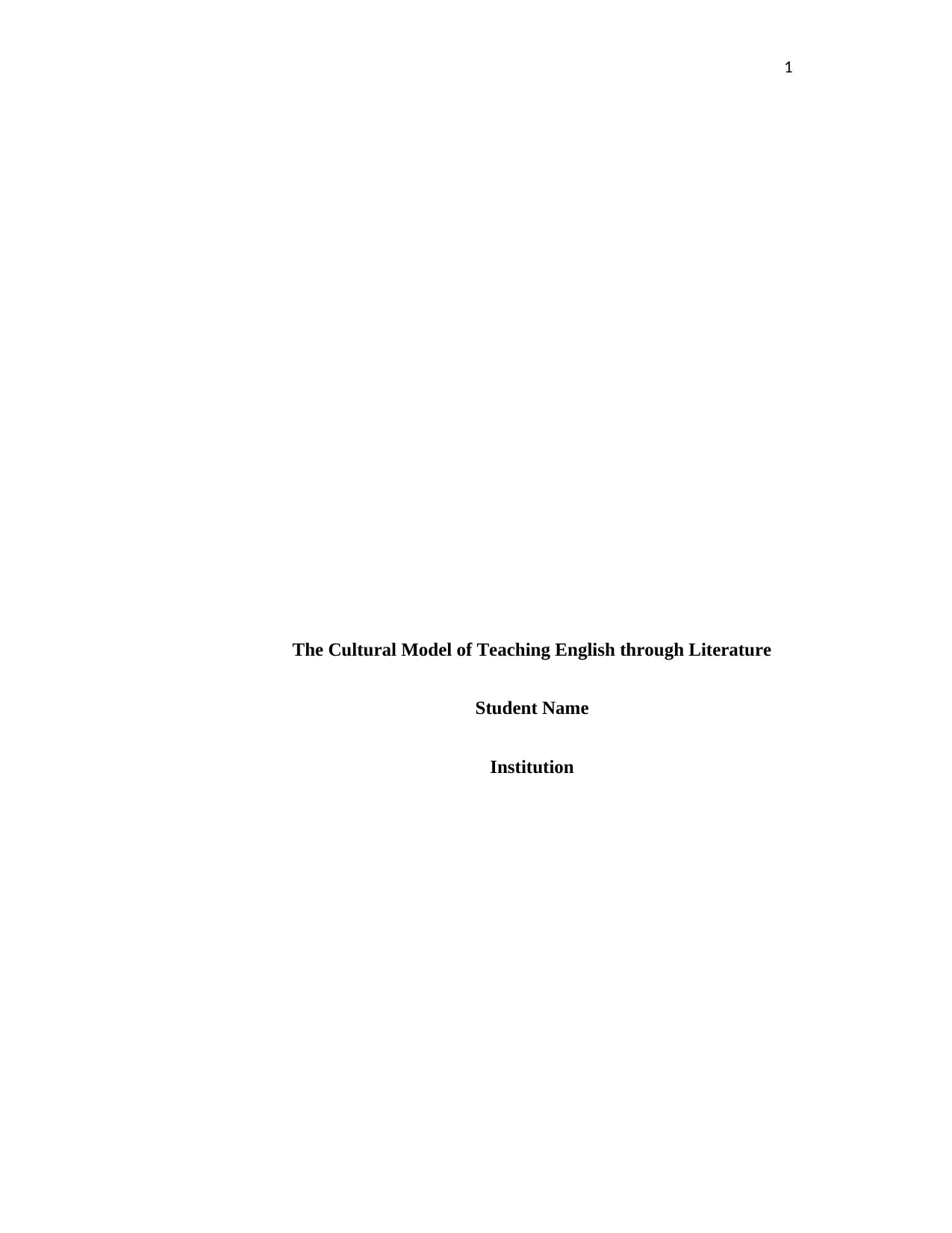
1
The Cultural Model of Teaching English through Literature
Student Name
Institution
The Cultural Model of Teaching English through Literature
Student Name
Institution
Paraphrase This Document
Need a fresh take? Get an instant paraphrase of this document with our AI Paraphraser
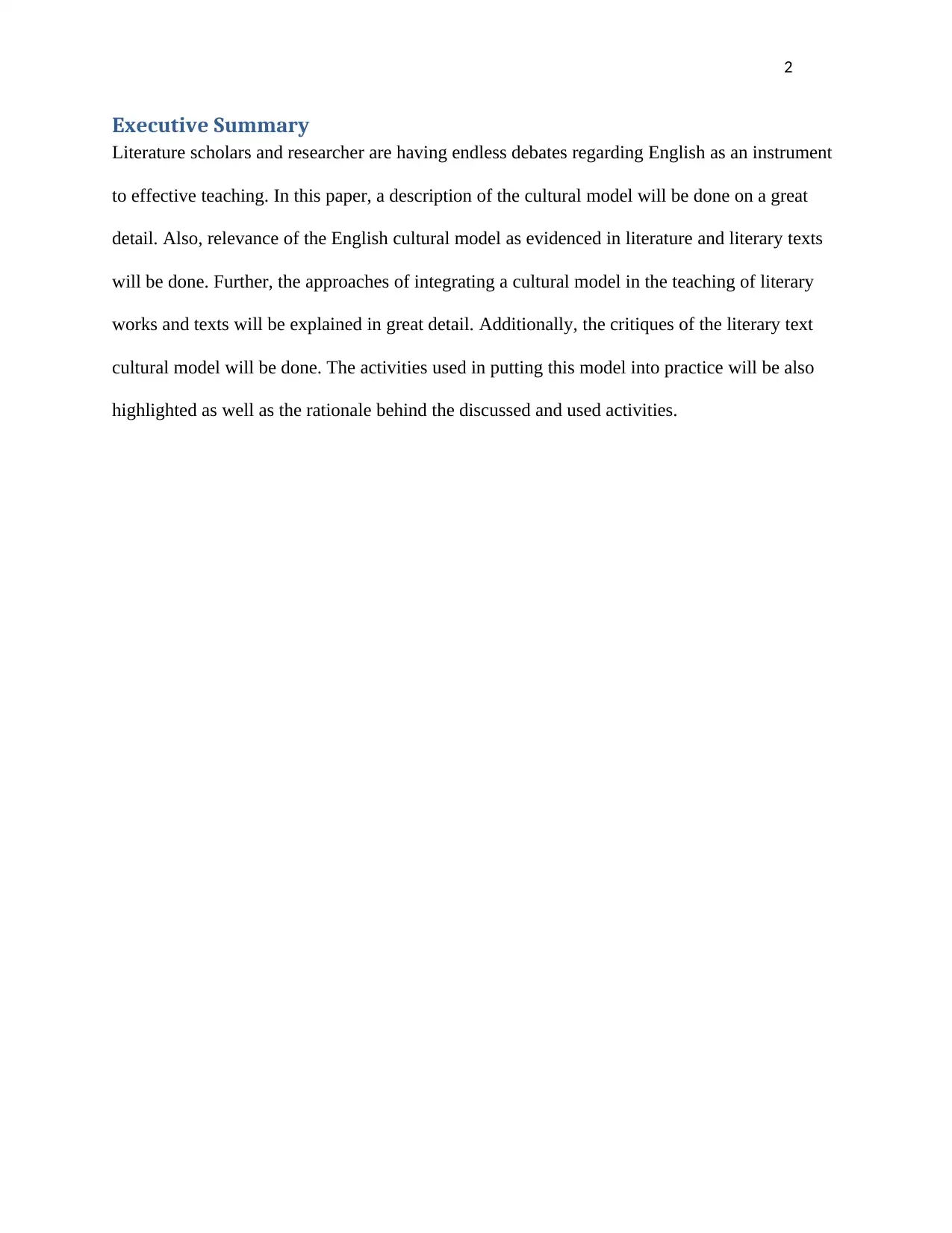
2
Executive Summary
Literature scholars and researcher are having endless debates regarding English as an instrument
to effective teaching. In this paper, a description of the cultural model will be done on a great
detail. Also, relevance of the English cultural model as evidenced in literature and literary texts
will be done. Further, the approaches of integrating a cultural model in the teaching of literary
works and texts will be explained in great detail. Additionally, the critiques of the literary text
cultural model will be done. The activities used in putting this model into practice will be also
highlighted as well as the rationale behind the discussed and used activities.
Executive Summary
Literature scholars and researcher are having endless debates regarding English as an instrument
to effective teaching. In this paper, a description of the cultural model will be done on a great
detail. Also, relevance of the English cultural model as evidenced in literature and literary texts
will be done. Further, the approaches of integrating a cultural model in the teaching of literary
works and texts will be explained in great detail. Additionally, the critiques of the literary text
cultural model will be done. The activities used in putting this model into practice will be also
highlighted as well as the rationale behind the discussed and used activities.
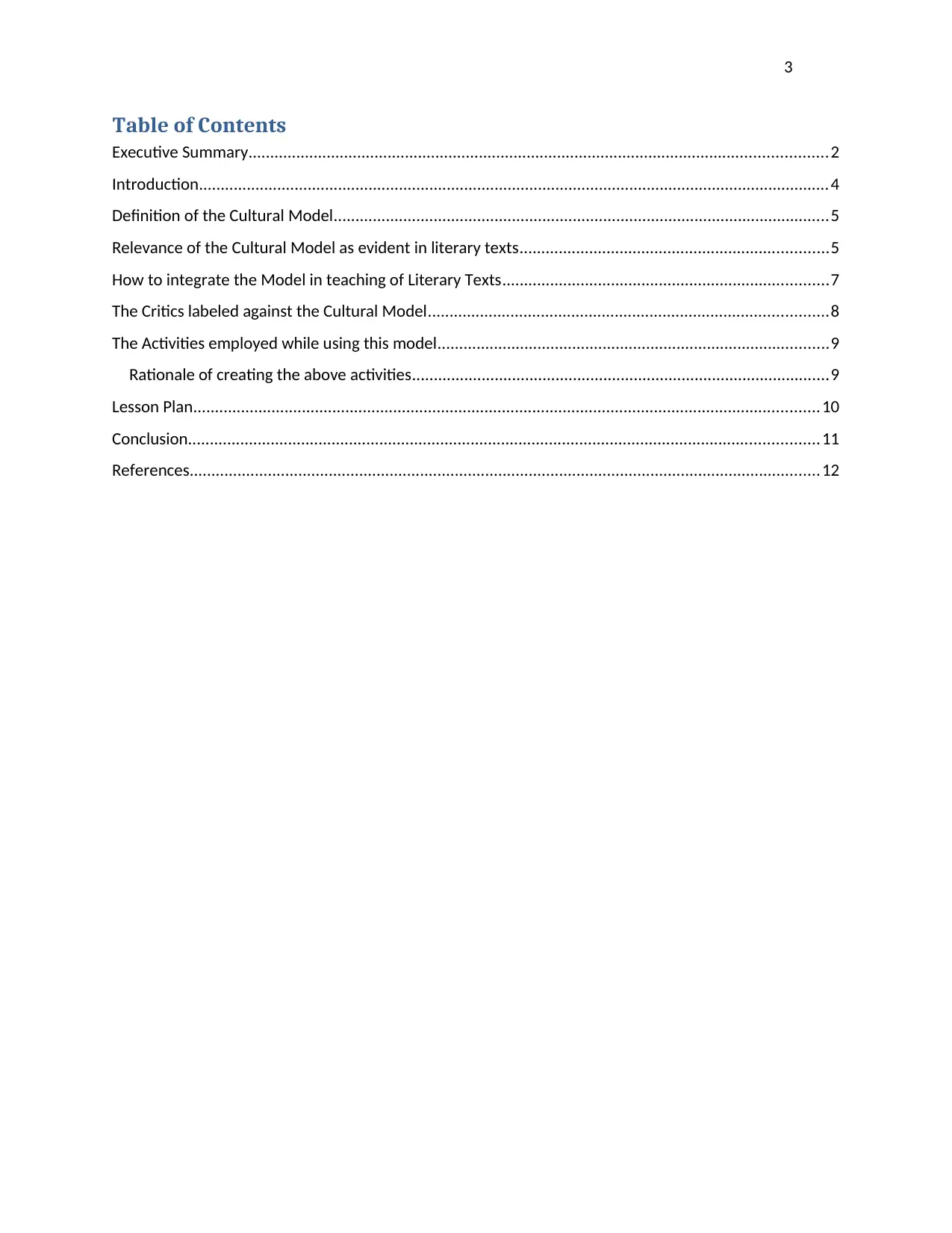
3
Table of Contents
Executive Summary.....................................................................................................................................2
Introduction.................................................................................................................................................4
Definition of the Cultural Model..................................................................................................................5
Relevance of the Cultural Model as evident in literary texts.......................................................................5
How to integrate the Model in teaching of Literary Texts...........................................................................7
The Critics labeled against the Cultural Model............................................................................................8
The Activities employed while using this model..........................................................................................9
Rationale of creating the above activities................................................................................................9
Lesson Plan................................................................................................................................................10
Conclusion.................................................................................................................................................11
References.................................................................................................................................................12
Table of Contents
Executive Summary.....................................................................................................................................2
Introduction.................................................................................................................................................4
Definition of the Cultural Model..................................................................................................................5
Relevance of the Cultural Model as evident in literary texts.......................................................................5
How to integrate the Model in teaching of Literary Texts...........................................................................7
The Critics labeled against the Cultural Model............................................................................................8
The Activities employed while using this model..........................................................................................9
Rationale of creating the above activities................................................................................................9
Lesson Plan................................................................................................................................................10
Conclusion.................................................................................................................................................11
References.................................................................................................................................................12
⊘ This is a preview!⊘
Do you want full access?
Subscribe today to unlock all pages.

Trusted by 1+ million students worldwide
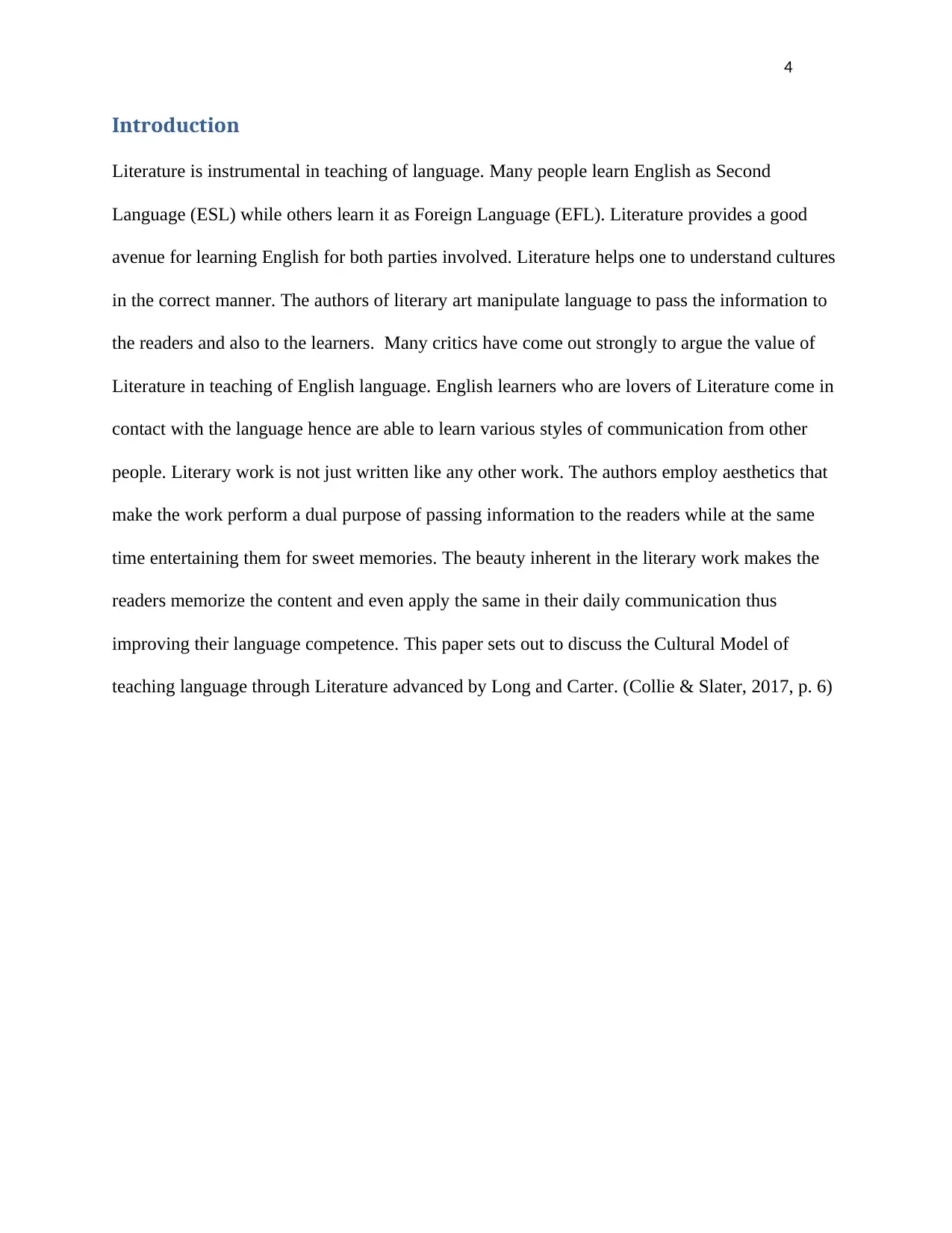
4
Introduction
Literature is instrumental in teaching of language. Many people learn English as Second
Language (ESL) while others learn it as Foreign Language (EFL). Literature provides a good
avenue for learning English for both parties involved. Literature helps one to understand cultures
in the correct manner. The authors of literary art manipulate language to pass the information to
the readers and also to the learners. Many critics have come out strongly to argue the value of
Literature in teaching of English language. English learners who are lovers of Literature come in
contact with the language hence are able to learn various styles of communication from other
people. Literary work is not just written like any other work. The authors employ aesthetics that
make the work perform a dual purpose of passing information to the readers while at the same
time entertaining them for sweet memories. The beauty inherent in the literary work makes the
readers memorize the content and even apply the same in their daily communication thus
improving their language competence. This paper sets out to discuss the Cultural Model of
teaching language through Literature advanced by Long and Carter. (Collie & Slater, 2017, p. 6)
Introduction
Literature is instrumental in teaching of language. Many people learn English as Second
Language (ESL) while others learn it as Foreign Language (EFL). Literature provides a good
avenue for learning English for both parties involved. Literature helps one to understand cultures
in the correct manner. The authors of literary art manipulate language to pass the information to
the readers and also to the learners. Many critics have come out strongly to argue the value of
Literature in teaching of English language. English learners who are lovers of Literature come in
contact with the language hence are able to learn various styles of communication from other
people. Literary work is not just written like any other work. The authors employ aesthetics that
make the work perform a dual purpose of passing information to the readers while at the same
time entertaining them for sweet memories. The beauty inherent in the literary work makes the
readers memorize the content and even apply the same in their daily communication thus
improving their language competence. This paper sets out to discuss the Cultural Model of
teaching language through Literature advanced by Long and Carter. (Collie & Slater, 2017, p. 6)
Paraphrase This Document
Need a fresh take? Get an instant paraphrase of this document with our AI Paraphraser
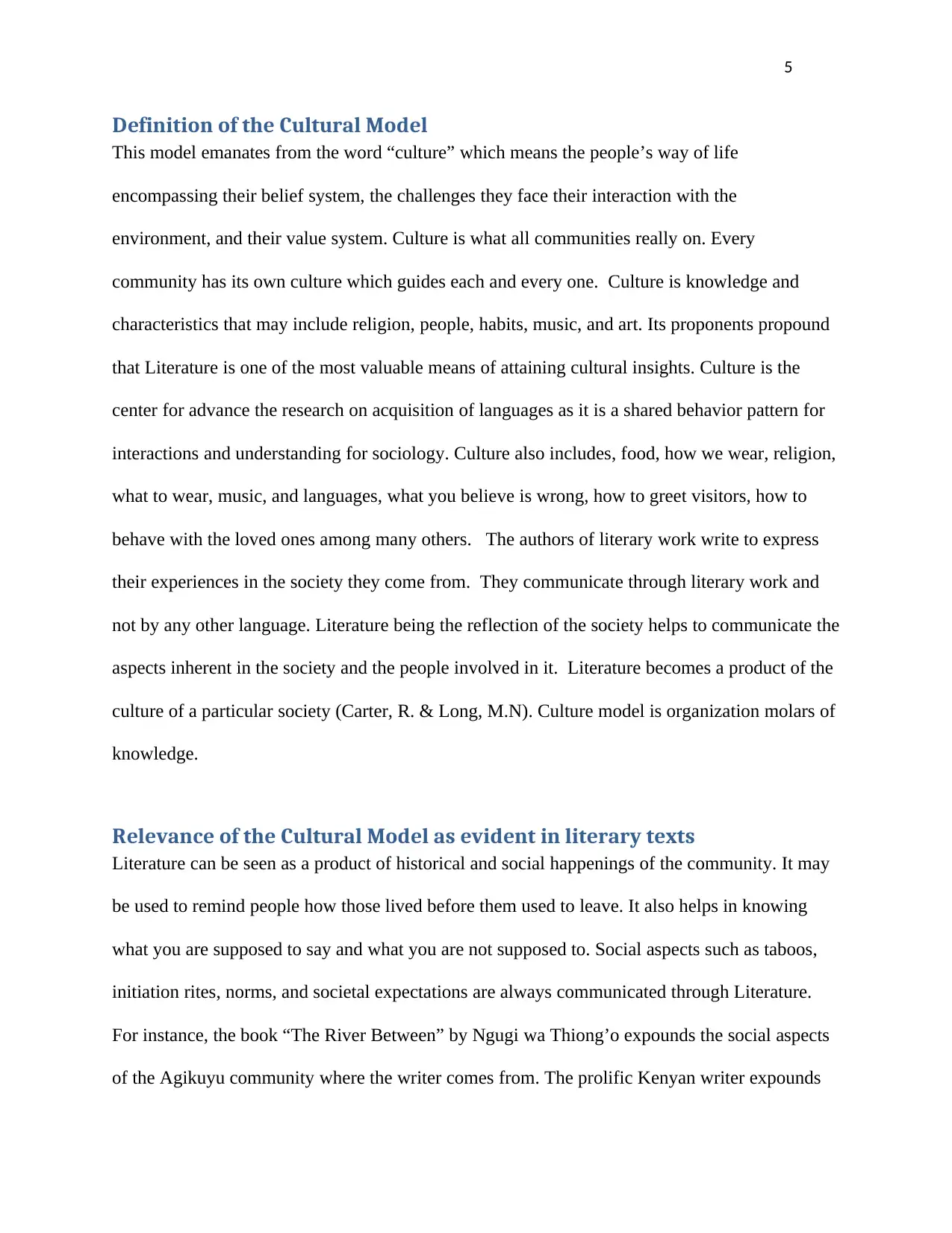
5
Definition of the Cultural Model
This model emanates from the word “culture” which means the people’s way of life
encompassing their belief system, the challenges they face their interaction with the
environment, and their value system. Culture is what all communities really on. Every
community has its own culture which guides each and every one. Culture is knowledge and
characteristics that may include religion, people, habits, music, and art. Its proponents propound
that Literature is one of the most valuable means of attaining cultural insights. Culture is the
center for advance the research on acquisition of languages as it is a shared behavior pattern for
interactions and understanding for sociology. Culture also includes, food, how we wear, religion,
what to wear, music, and languages, what you believe is wrong, how to greet visitors, how to
behave with the loved ones among many others. The authors of literary work write to express
their experiences in the society they come from. They communicate through literary work and
not by any other language. Literature being the reflection of the society helps to communicate the
aspects inherent in the society and the people involved in it. Literature becomes a product of the
culture of a particular society (Carter, R. & Long, M.N). Culture model is organization molars of
knowledge.
Relevance of the Cultural Model as evident in literary texts
Literature can be seen as a product of historical and social happenings of the community. It may
be used to remind people how those lived before them used to leave. It also helps in knowing
what you are supposed to say and what you are not supposed to. Social aspects such as taboos,
initiation rites, norms, and societal expectations are always communicated through Literature.
For instance, the book “The River Between” by Ngugi wa Thiong’o expounds the social aspects
of the Agikuyu community where the writer comes from. The prolific Kenyan writer expounds
Definition of the Cultural Model
This model emanates from the word “culture” which means the people’s way of life
encompassing their belief system, the challenges they face their interaction with the
environment, and their value system. Culture is what all communities really on. Every
community has its own culture which guides each and every one. Culture is knowledge and
characteristics that may include religion, people, habits, music, and art. Its proponents propound
that Literature is one of the most valuable means of attaining cultural insights. Culture is the
center for advance the research on acquisition of languages as it is a shared behavior pattern for
interactions and understanding for sociology. Culture also includes, food, how we wear, religion,
what to wear, music, and languages, what you believe is wrong, how to greet visitors, how to
behave with the loved ones among many others. The authors of literary work write to express
their experiences in the society they come from. They communicate through literary work and
not by any other language. Literature being the reflection of the society helps to communicate the
aspects inherent in the society and the people involved in it. Literature becomes a product of the
culture of a particular society (Carter, R. & Long, M.N). Culture model is organization molars of
knowledge.
Relevance of the Cultural Model as evident in literary texts
Literature can be seen as a product of historical and social happenings of the community. It may
be used to remind people how those lived before them used to leave. It also helps in knowing
what you are supposed to say and what you are not supposed to. Social aspects such as taboos,
initiation rites, norms, and societal expectations are always communicated through Literature.
For instance, the book “The River Between” by Ngugi wa Thiong’o expounds the social aspects
of the Agikuyu community where the writer comes from. The prolific Kenyan writer expounds
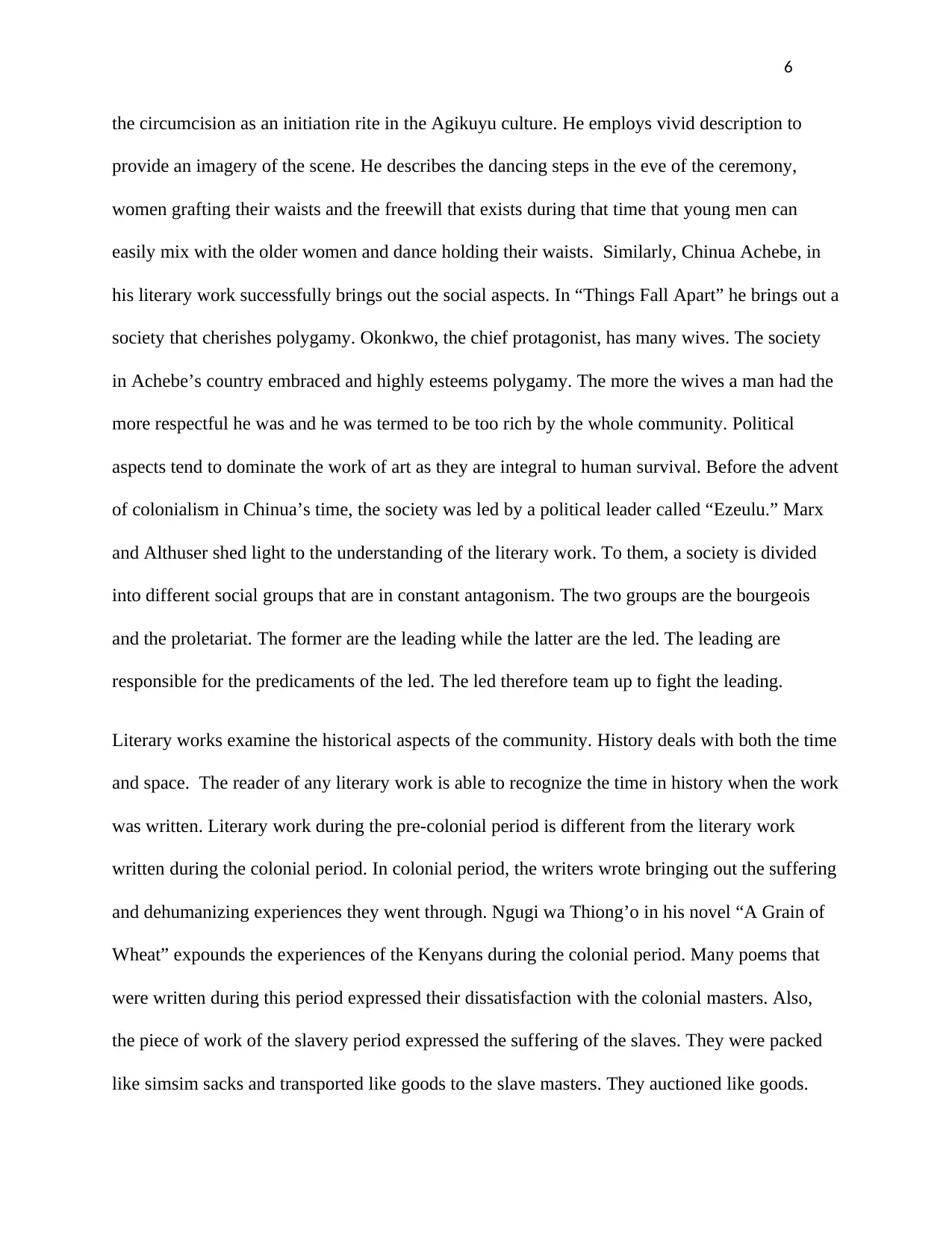
6
the circumcision as an initiation rite in the Agikuyu culture. He employs vivid description to
provide an imagery of the scene. He describes the dancing steps in the eve of the ceremony,
women grafting their waists and the freewill that exists during that time that young men can
easily mix with the older women and dance holding their waists. Similarly, Chinua Achebe, in
his literary work successfully brings out the social aspects. In “Things Fall Apart” he brings out a
society that cherishes polygamy. Okonkwo, the chief protagonist, has many wives. The society
in Achebe’s country embraced and highly esteems polygamy. The more the wives a man had the
more respectful he was and he was termed to be too rich by the whole community. Political
aspects tend to dominate the work of art as they are integral to human survival. Before the advent
of colonialism in Chinua’s time, the society was led by a political leader called “Ezeulu.” Marx
and Althuser shed light to the understanding of the literary work. To them, a society is divided
into different social groups that are in constant antagonism. The two groups are the bourgeois
and the proletariat. The former are the leading while the latter are the led. The leading are
responsible for the predicaments of the led. The led therefore team up to fight the leading.
Literary works examine the historical aspects of the community. History deals with both the time
and space. The reader of any literary work is able to recognize the time in history when the work
was written. Literary work during the pre-colonial period is different from the literary work
written during the colonial period. In colonial period, the writers wrote bringing out the suffering
and dehumanizing experiences they went through. Ngugi wa Thiong’o in his novel “A Grain of
Wheat” expounds the experiences of the Kenyans during the colonial period. Many poems that
were written during this period expressed their dissatisfaction with the colonial masters. Also,
the piece of work of the slavery period expressed the suffering of the slaves. They were packed
like simsim sacks and transported like goods to the slave masters. They auctioned like goods.
the circumcision as an initiation rite in the Agikuyu culture. He employs vivid description to
provide an imagery of the scene. He describes the dancing steps in the eve of the ceremony,
women grafting their waists and the freewill that exists during that time that young men can
easily mix with the older women and dance holding their waists. Similarly, Chinua Achebe, in
his literary work successfully brings out the social aspects. In “Things Fall Apart” he brings out a
society that cherishes polygamy. Okonkwo, the chief protagonist, has many wives. The society
in Achebe’s country embraced and highly esteems polygamy. The more the wives a man had the
more respectful he was and he was termed to be too rich by the whole community. Political
aspects tend to dominate the work of art as they are integral to human survival. Before the advent
of colonialism in Chinua’s time, the society was led by a political leader called “Ezeulu.” Marx
and Althuser shed light to the understanding of the literary work. To them, a society is divided
into different social groups that are in constant antagonism. The two groups are the bourgeois
and the proletariat. The former are the leading while the latter are the led. The leading are
responsible for the predicaments of the led. The led therefore team up to fight the leading.
Literary works examine the historical aspects of the community. History deals with both the time
and space. The reader of any literary work is able to recognize the time in history when the work
was written. Literary work during the pre-colonial period is different from the literary work
written during the colonial period. In colonial period, the writers wrote bringing out the suffering
and dehumanizing experiences they went through. Ngugi wa Thiong’o in his novel “A Grain of
Wheat” expounds the experiences of the Kenyans during the colonial period. Many poems that
were written during this period expressed their dissatisfaction with the colonial masters. Also,
the piece of work of the slavery period expressed the suffering of the slaves. They were packed
like simsim sacks and transported like goods to the slave masters. They auctioned like goods.
⊘ This is a preview!⊘
Do you want full access?
Subscribe today to unlock all pages.

Trusted by 1+ million students worldwide
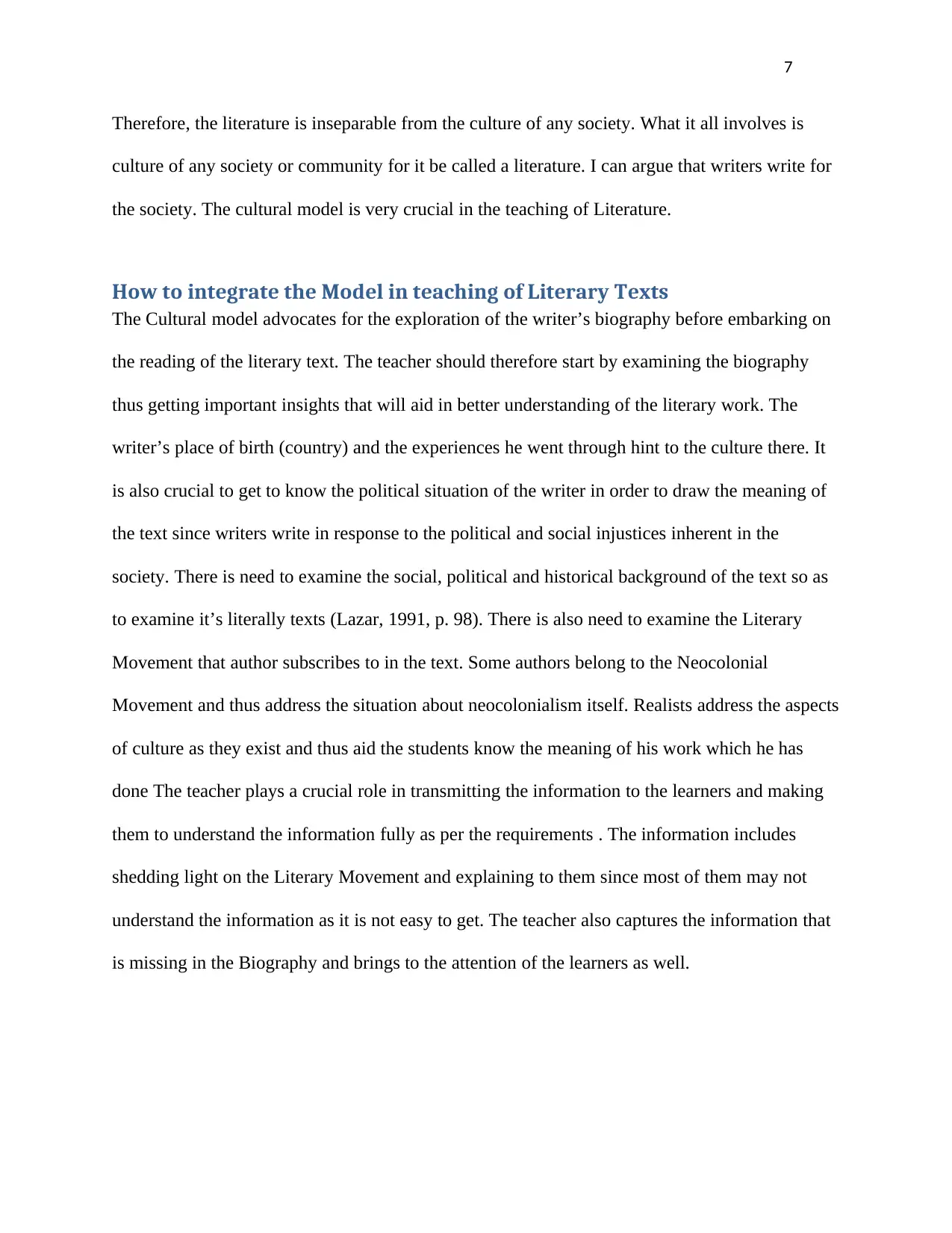
7
Therefore, the literature is inseparable from the culture of any society. What it all involves is
culture of any society or community for it be called a literature. I can argue that writers write for
the society. The cultural model is very crucial in the teaching of Literature.
How to integrate the Model in teaching of Literary Texts
The Cultural model advocates for the exploration of the writer’s biography before embarking on
the reading of the literary text. The teacher should therefore start by examining the biography
thus getting important insights that will aid in better understanding of the literary work. The
writer’s place of birth (country) and the experiences he went through hint to the culture there. It
is also crucial to get to know the political situation of the writer in order to draw the meaning of
the text since writers write in response to the political and social injustices inherent in the
society. There is need to examine the social, political and historical background of the text so as
to examine it’s literally texts (Lazar, 1991, p. 98). There is also need to examine the Literary
Movement that author subscribes to in the text. Some authors belong to the Neocolonial
Movement and thus address the situation about neocolonialism itself. Realists address the aspects
of culture as they exist and thus aid the students know the meaning of his work which he has
done The teacher plays a crucial role in transmitting the information to the learners and making
them to understand the information fully as per the requirements . The information includes
shedding light on the Literary Movement and explaining to them since most of them may not
understand the information as it is not easy to get. The teacher also captures the information that
is missing in the Biography and brings to the attention of the learners as well.
Therefore, the literature is inseparable from the culture of any society. What it all involves is
culture of any society or community for it be called a literature. I can argue that writers write for
the society. The cultural model is very crucial in the teaching of Literature.
How to integrate the Model in teaching of Literary Texts
The Cultural model advocates for the exploration of the writer’s biography before embarking on
the reading of the literary text. The teacher should therefore start by examining the biography
thus getting important insights that will aid in better understanding of the literary work. The
writer’s place of birth (country) and the experiences he went through hint to the culture there. It
is also crucial to get to know the political situation of the writer in order to draw the meaning of
the text since writers write in response to the political and social injustices inherent in the
society. There is need to examine the social, political and historical background of the text so as
to examine it’s literally texts (Lazar, 1991, p. 98). There is also need to examine the Literary
Movement that author subscribes to in the text. Some authors belong to the Neocolonial
Movement and thus address the situation about neocolonialism itself. Realists address the aspects
of culture as they exist and thus aid the students know the meaning of his work which he has
done The teacher plays a crucial role in transmitting the information to the learners and making
them to understand the information fully as per the requirements . The information includes
shedding light on the Literary Movement and explaining to them since most of them may not
understand the information as it is not easy to get. The teacher also captures the information that
is missing in the Biography and brings to the attention of the learners as well.
Paraphrase This Document
Need a fresh take? Get an instant paraphrase of this document with our AI Paraphraser
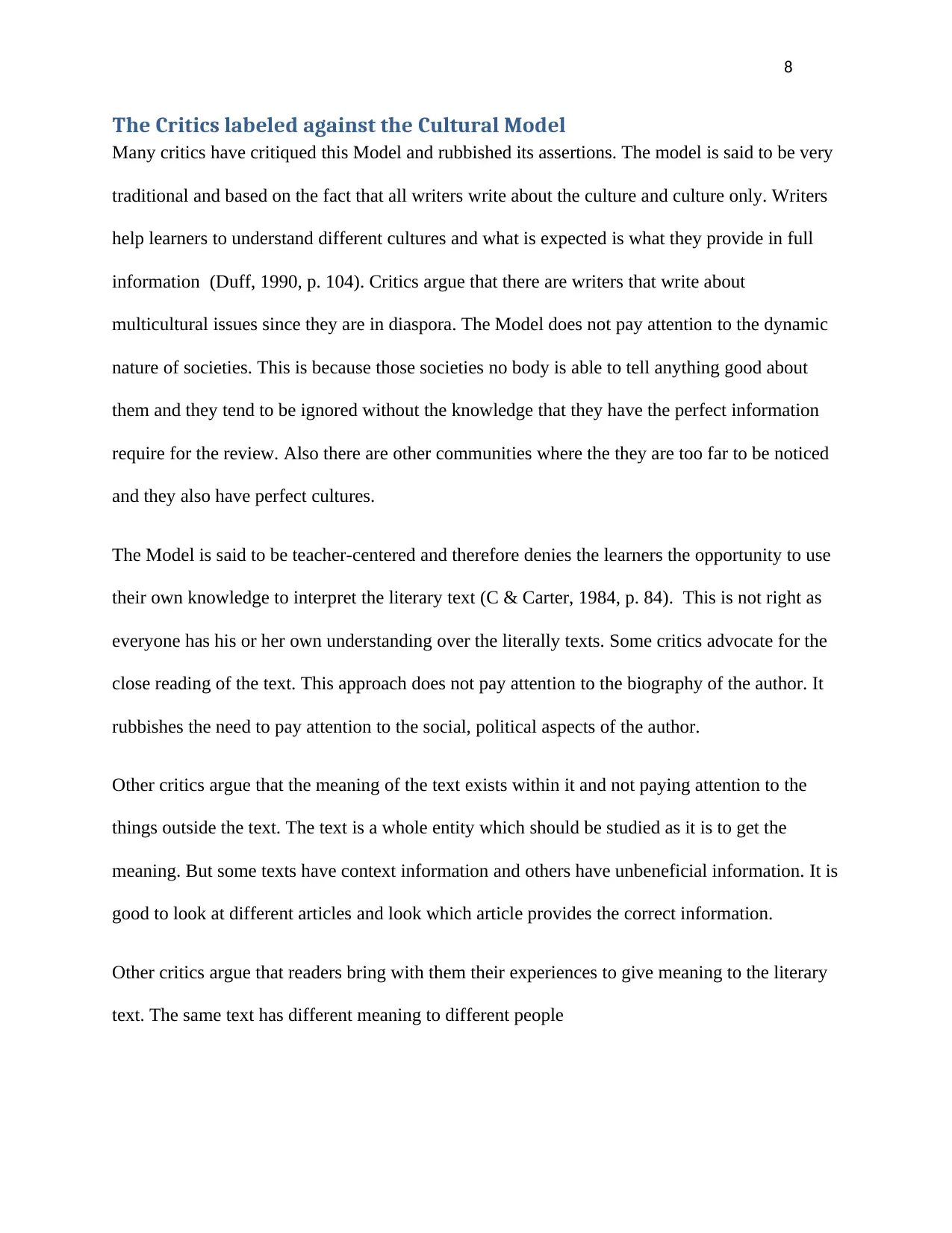
8
The Critics labeled against the Cultural Model
Many critics have critiqued this Model and rubbished its assertions. The model is said to be very
traditional and based on the fact that all writers write about the culture and culture only. Writers
help learners to understand different cultures and what is expected is what they provide in full
information (Duff, 1990, p. 104). Critics argue that there are writers that write about
multicultural issues since they are in diaspora. The Model does not pay attention to the dynamic
nature of societies. This is because those societies no body is able to tell anything good about
them and they tend to be ignored without the knowledge that they have the perfect information
require for the review. Also there are other communities where the they are too far to be noticed
and they also have perfect cultures.
The Model is said to be teacher-centered and therefore denies the learners the opportunity to use
their own knowledge to interpret the literary text (C & Carter, 1984, p. 84). This is not right as
everyone has his or her own understanding over the literally texts. Some critics advocate for the
close reading of the text. This approach does not pay attention to the biography of the author. It
rubbishes the need to pay attention to the social, political aspects of the author.
Other critics argue that the meaning of the text exists within it and not paying attention to the
things outside the text. The text is a whole entity which should be studied as it is to get the
meaning. But some texts have context information and others have unbeneficial information. It is
good to look at different articles and look which article provides the correct information.
Other critics argue that readers bring with them their experiences to give meaning to the literary
text. The same text has different meaning to different people
The Critics labeled against the Cultural Model
Many critics have critiqued this Model and rubbished its assertions. The model is said to be very
traditional and based on the fact that all writers write about the culture and culture only. Writers
help learners to understand different cultures and what is expected is what they provide in full
information (Duff, 1990, p. 104). Critics argue that there are writers that write about
multicultural issues since they are in diaspora. The Model does not pay attention to the dynamic
nature of societies. This is because those societies no body is able to tell anything good about
them and they tend to be ignored without the knowledge that they have the perfect information
require for the review. Also there are other communities where the they are too far to be noticed
and they also have perfect cultures.
The Model is said to be teacher-centered and therefore denies the learners the opportunity to use
their own knowledge to interpret the literary text (C & Carter, 1984, p. 84). This is not right as
everyone has his or her own understanding over the literally texts. Some critics advocate for the
close reading of the text. This approach does not pay attention to the biography of the author. It
rubbishes the need to pay attention to the social, political aspects of the author.
Other critics argue that the meaning of the text exists within it and not paying attention to the
things outside the text. The text is a whole entity which should be studied as it is to get the
meaning. But some texts have context information and others have unbeneficial information. It is
good to look at different articles and look which article provides the correct information.
Other critics argue that readers bring with them their experiences to give meaning to the literary
text. The same text has different meaning to different people
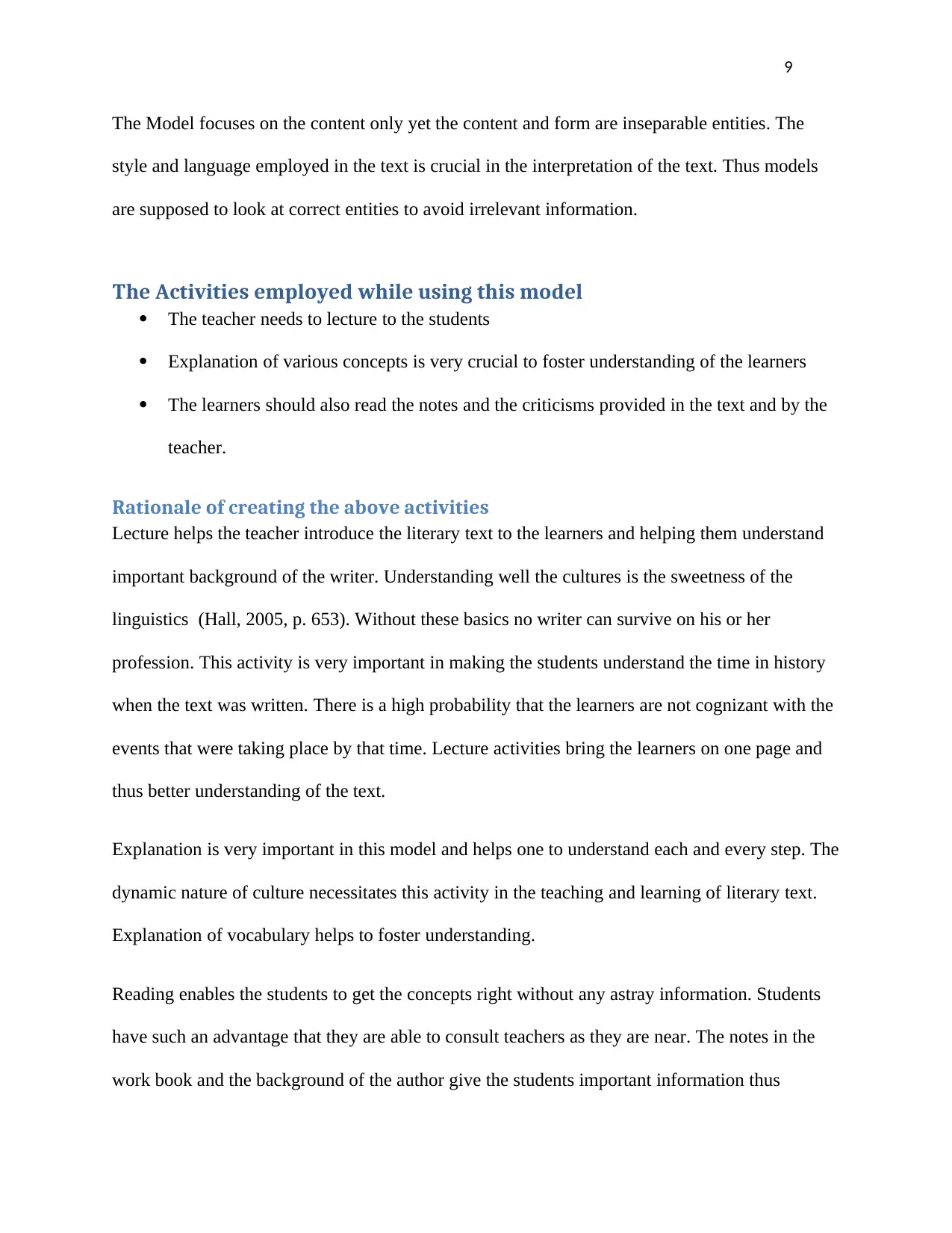
9
The Model focuses on the content only yet the content and form are inseparable entities. The
style and language employed in the text is crucial in the interpretation of the text. Thus models
are supposed to look at correct entities to avoid irrelevant information.
The Activities employed while using this model
The teacher needs to lecture to the students
Explanation of various concepts is very crucial to foster understanding of the learners
The learners should also read the notes and the criticisms provided in the text and by the
teacher.
Rationale of creating the above activities
Lecture helps the teacher introduce the literary text to the learners and helping them understand
important background of the writer. Understanding well the cultures is the sweetness of the
linguistics (Hall, 2005, p. 653). Without these basics no writer can survive on his or her
profession. This activity is very important in making the students understand the time in history
when the text was written. There is a high probability that the learners are not cognizant with the
events that were taking place by that time. Lecture activities bring the learners on one page and
thus better understanding of the text.
Explanation is very important in this model and helps one to understand each and every step. The
dynamic nature of culture necessitates this activity in the teaching and learning of literary text.
Explanation of vocabulary helps to foster understanding.
Reading enables the students to get the concepts right without any astray information. Students
have such an advantage that they are able to consult teachers as they are near. The notes in the
work book and the background of the author give the students important information thus
The Model focuses on the content only yet the content and form are inseparable entities. The
style and language employed in the text is crucial in the interpretation of the text. Thus models
are supposed to look at correct entities to avoid irrelevant information.
The Activities employed while using this model
The teacher needs to lecture to the students
Explanation of various concepts is very crucial to foster understanding of the learners
The learners should also read the notes and the criticisms provided in the text and by the
teacher.
Rationale of creating the above activities
Lecture helps the teacher introduce the literary text to the learners and helping them understand
important background of the writer. Understanding well the cultures is the sweetness of the
linguistics (Hall, 2005, p. 653). Without these basics no writer can survive on his or her
profession. This activity is very important in making the students understand the time in history
when the text was written. There is a high probability that the learners are not cognizant with the
events that were taking place by that time. Lecture activities bring the learners on one page and
thus better understanding of the text.
Explanation is very important in this model and helps one to understand each and every step. The
dynamic nature of culture necessitates this activity in the teaching and learning of literary text.
Explanation of vocabulary helps to foster understanding.
Reading enables the students to get the concepts right without any astray information. Students
have such an advantage that they are able to consult teachers as they are near. The notes in the
work book and the background of the author give the students important information thus
⊘ This is a preview!⊘
Do you want full access?
Subscribe today to unlock all pages.

Trusted by 1+ million students worldwide
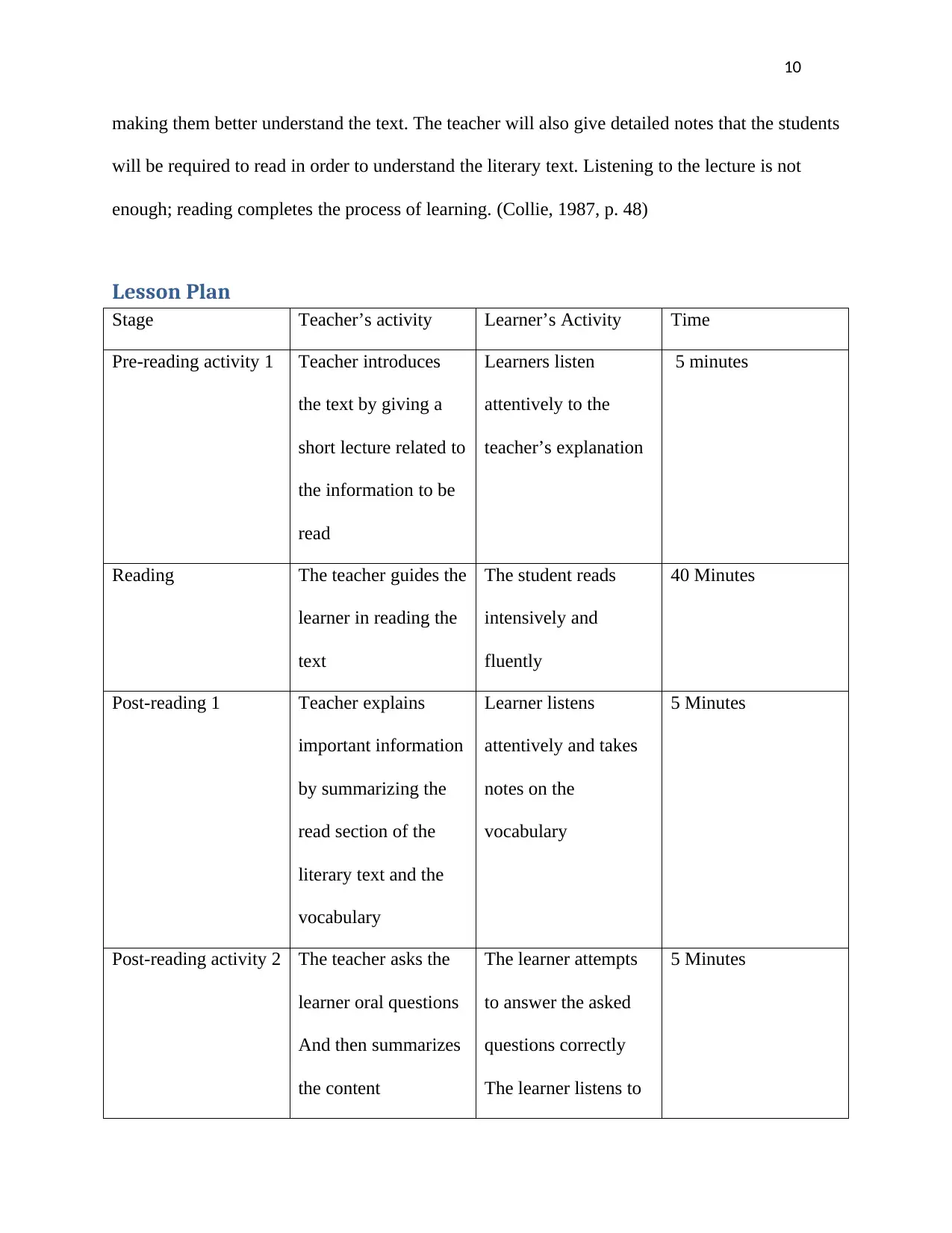
10
making them better understand the text. The teacher will also give detailed notes that the students
will be required to read in order to understand the literary text. Listening to the lecture is not
enough; reading completes the process of learning. (Collie, 1987, p. 48)
Lesson Plan
Stage Teacher’s activity Learner’s Activity Time
Pre-reading activity 1 Teacher introduces
the text by giving a
short lecture related to
the information to be
read
Learners listen
attentively to the
teacher’s explanation
5 minutes
Reading The teacher guides the
learner in reading the
text
The student reads
intensively and
fluently
40 Minutes
Post-reading 1 Teacher explains
important information
by summarizing the
read section of the
literary text and the
vocabulary
Learner listens
attentively and takes
notes on the
vocabulary
5 Minutes
Post-reading activity 2 The teacher asks the
learner oral questions
And then summarizes
the content
The learner attempts
to answer the asked
questions correctly
The learner listens to
5 Minutes
making them better understand the text. The teacher will also give detailed notes that the students
will be required to read in order to understand the literary text. Listening to the lecture is not
enough; reading completes the process of learning. (Collie, 1987, p. 48)
Lesson Plan
Stage Teacher’s activity Learner’s Activity Time
Pre-reading activity 1 Teacher introduces
the text by giving a
short lecture related to
the information to be
read
Learners listen
attentively to the
teacher’s explanation
5 minutes
Reading The teacher guides the
learner in reading the
text
The student reads
intensively and
fluently
40 Minutes
Post-reading 1 Teacher explains
important information
by summarizing the
read section of the
literary text and the
vocabulary
Learner listens
attentively and takes
notes on the
vocabulary
5 Minutes
Post-reading activity 2 The teacher asks the
learner oral questions
And then summarizes
the content
The learner attempts
to answer the asked
questions correctly
The learner listens to
5 Minutes
Paraphrase This Document
Need a fresh take? Get an instant paraphrase of this document with our AI Paraphraser
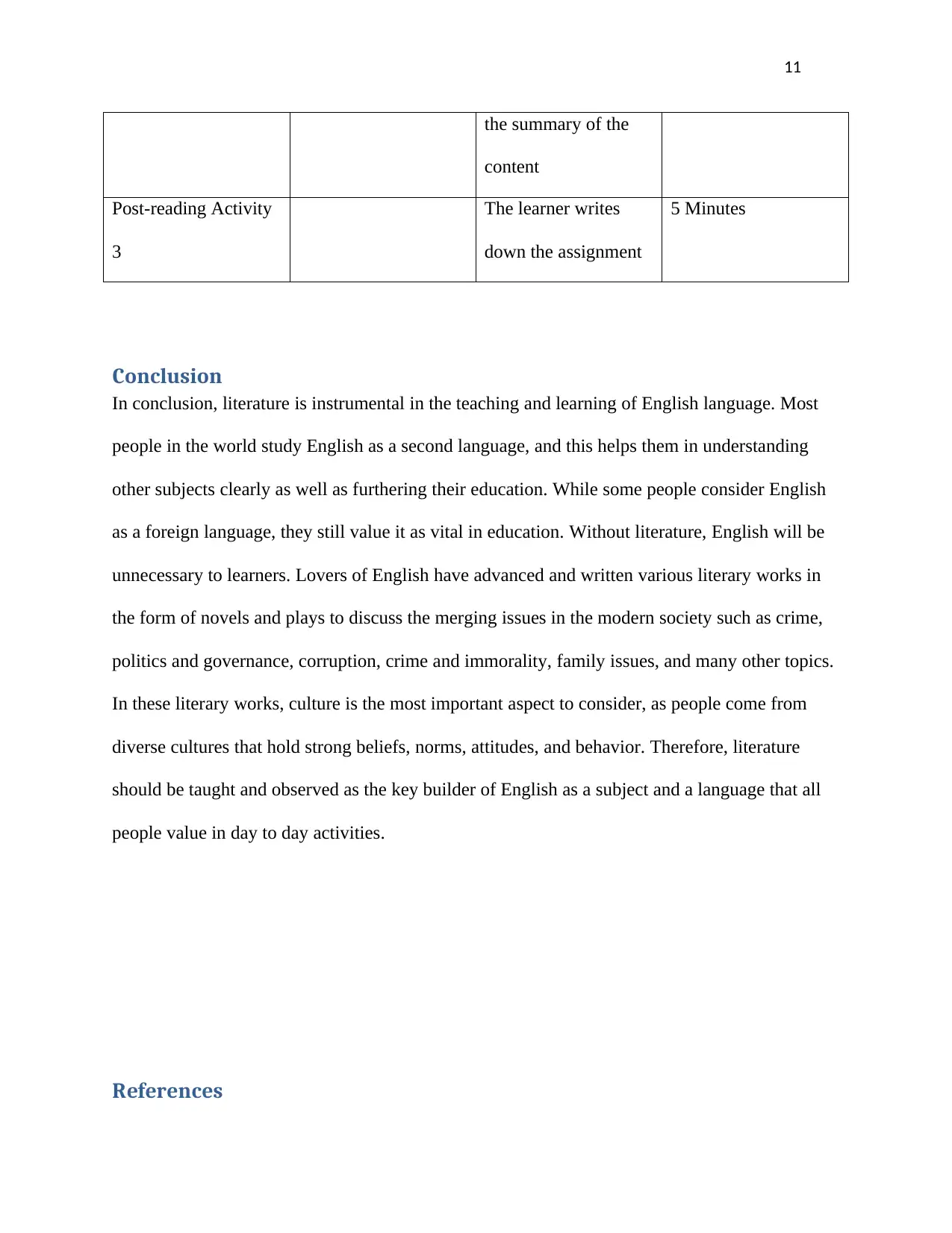
11
the summary of the
content
Post-reading Activity
3
The learner writes
down the assignment
5 Minutes
Conclusion
In conclusion, literature is instrumental in the teaching and learning of English language. Most
people in the world study English as a second language, and this helps them in understanding
other subjects clearly as well as furthering their education. While some people consider English
as a foreign language, they still value it as vital in education. Without literature, English will be
unnecessary to learners. Lovers of English have advanced and written various literary works in
the form of novels and plays to discuss the merging issues in the modern society such as crime,
politics and governance, corruption, crime and immorality, family issues, and many other topics.
In these literary works, culture is the most important aspect to consider, as people come from
diverse cultures that hold strong beliefs, norms, attitudes, and behavior. Therefore, literature
should be taught and observed as the key builder of English as a subject and a language that all
people value in day to day activities.
References
the summary of the
content
Post-reading Activity
3
The learner writes
down the assignment
5 Minutes
Conclusion
In conclusion, literature is instrumental in the teaching and learning of English language. Most
people in the world study English as a second language, and this helps them in understanding
other subjects clearly as well as furthering their education. While some people consider English
as a foreign language, they still value it as vital in education. Without literature, English will be
unnecessary to learners. Lovers of English have advanced and written various literary works in
the form of novels and plays to discuss the merging issues in the modern society such as crime,
politics and governance, corruption, crime and immorality, family issues, and many other topics.
In these literary works, culture is the most important aspect to consider, as people come from
diverse cultures that hold strong beliefs, norms, attitudes, and behavior. Therefore, literature
should be taught and observed as the key builder of English as a subject and a language that all
people value in day to day activities.
References
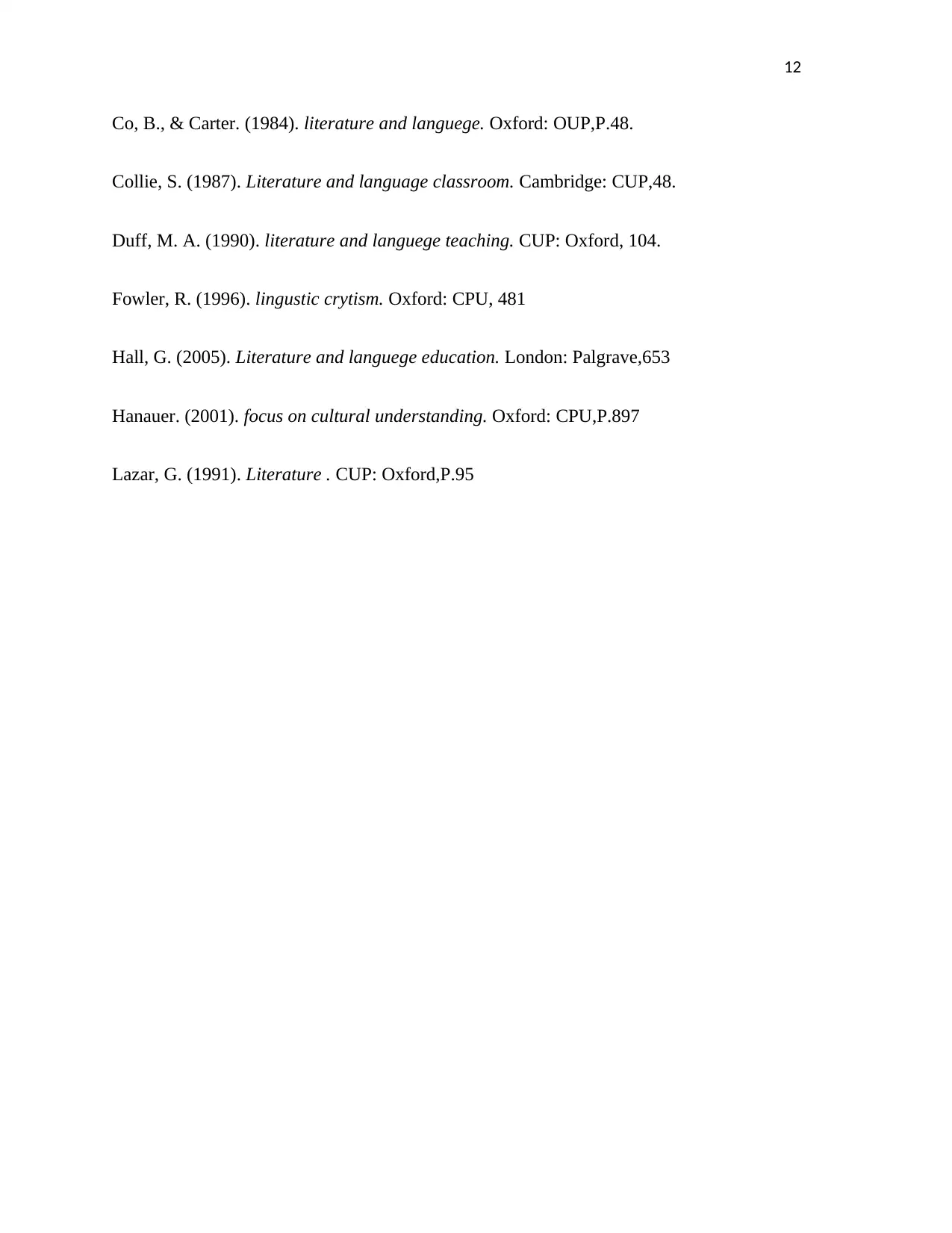
12
Co, B., & Carter. (1984). literature and languege. Oxford: OUP,P.48.
Collie, S. (1987). Literature and language classroom. Cambridge: CUP,48.
Duff, M. A. (1990). literature and languege teaching. CUP: Oxford, 104.
Fowler, R. (1996). lingustic crytism. Oxford: CPU, 481
Hall, G. (2005). Literature and languege education. London: Palgrave,653
Hanauer. (2001). focus on cultural understanding. Oxford: CPU,P.897
Lazar, G. (1991). Literature . CUP: Oxford,P.95
Co, B., & Carter. (1984). literature and languege. Oxford: OUP,P.48.
Collie, S. (1987). Literature and language classroom. Cambridge: CUP,48.
Duff, M. A. (1990). literature and languege teaching. CUP: Oxford, 104.
Fowler, R. (1996). lingustic crytism. Oxford: CPU, 481
Hall, G. (2005). Literature and languege education. London: Palgrave,653
Hanauer. (2001). focus on cultural understanding. Oxford: CPU,P.897
Lazar, G. (1991). Literature . CUP: Oxford,P.95
⊘ This is a preview!⊘
Do you want full access?
Subscribe today to unlock all pages.

Trusted by 1+ million students worldwide
1 out of 12
Related Documents
Your All-in-One AI-Powered Toolkit for Academic Success.
+13062052269
info@desklib.com
Available 24*7 on WhatsApp / Email
![[object Object]](/_next/static/media/star-bottom.7253800d.svg)
Unlock your academic potential
Copyright © 2020–2025 A2Z Services. All Rights Reserved. Developed and managed by ZUCOL.





